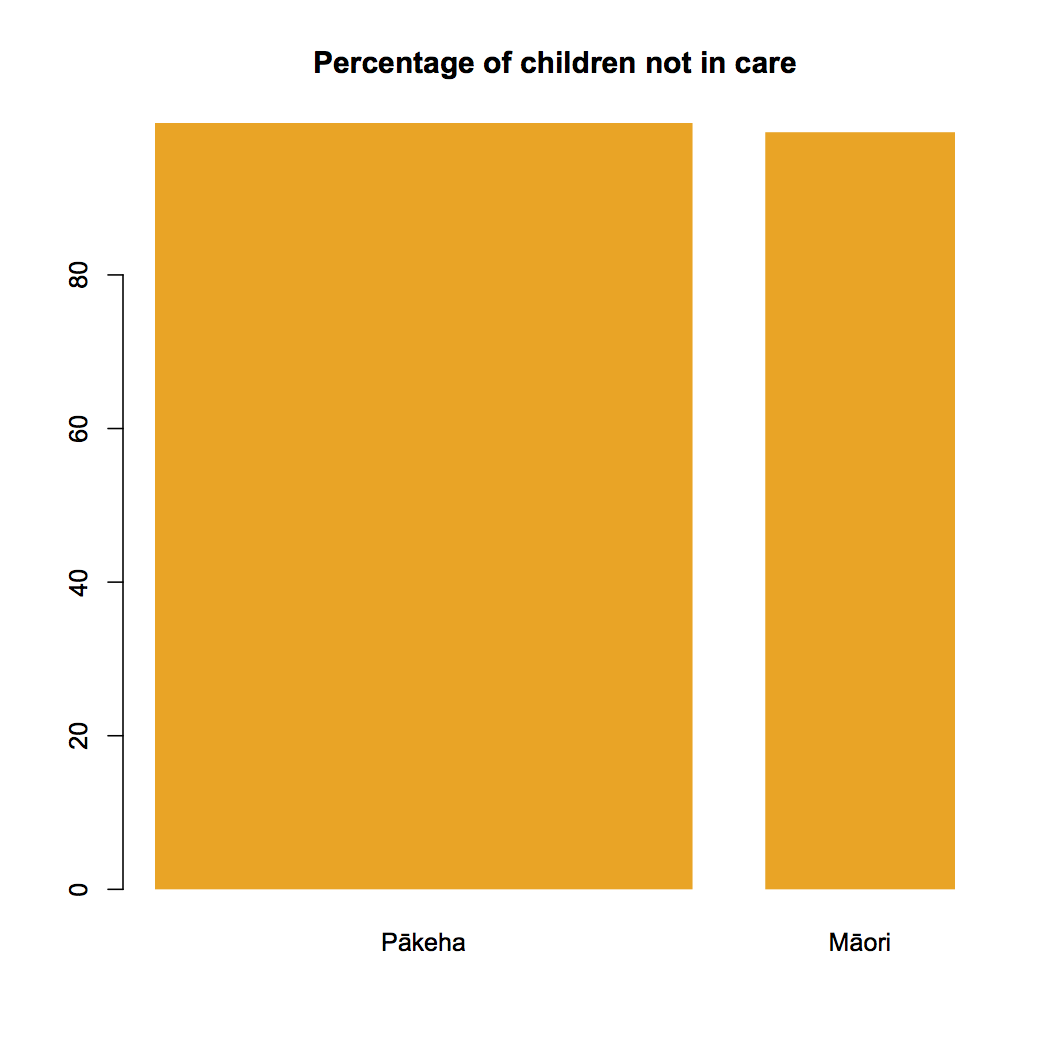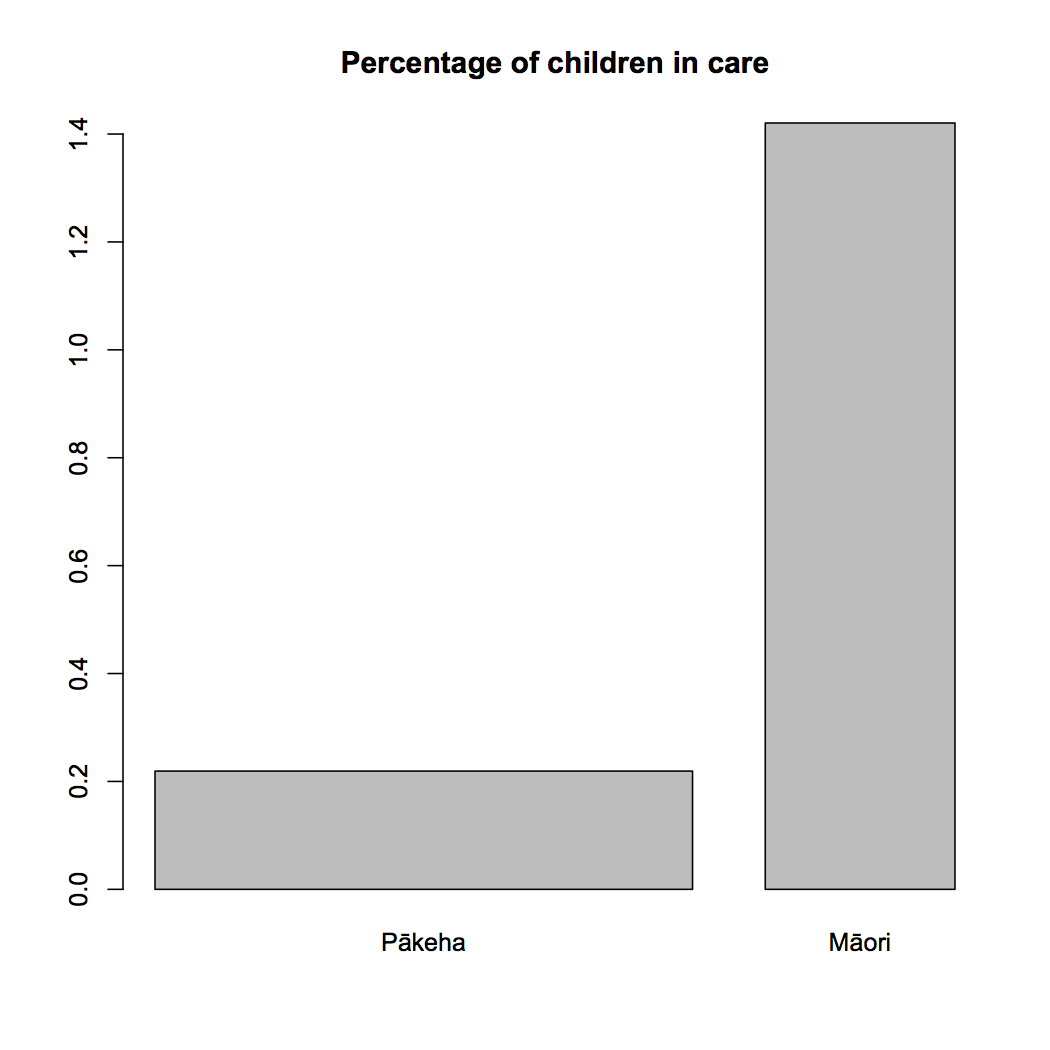Percentage not in care
From Newsroom, via Giovanni Tiso on Twitter
Oranga Tamariki chief executive Gráinne Moss defended her agency’s actions around uplifts to Parliament’s social services committee on Wednesday morning, saying 98.5 percent of Māori children were not in care.
First, that’s a really unnatural way to describe a small percent…
No, first, 1.5% is not a small percentage when you’re talking about proportion of “children and young people in the care of the Chief Executive”. It is, or should be, a shockingly large percentage. I went and checked it against the June 2017 figures, the most recent I could find with an ethnicity breakdown: the spreadsheet said 3518 Māori, 1538 Pākehā. Comparing that to 2013 census figures of about 270,000 children and young people reporting Māori ethnicity we get 1.3%, and the total number in care has gone up from 5708 in June 2017 to 6350 in the most recent annual report, so 1.5% is plausible. Graeme Edgeler was similarly motivated to check.
Given that, though, describing the figure as 98.5% not in care rather than 1.5% in care is really unnatural. While zero kids in care is unrealistically optimistic, it’s at least a meaningful reference point; zero kids not in care is a dystopian nightmare. It makes more sense to use the percentage in care if you’re trying to communicate accurately.
Here are two barplots:
Of course, these figures alone can’t answer questions about racism at Oranga Tamariki. Someone would need to talk to their staff, children in their care, families who have been separated from those children, and so on. Newsroom has been doing that.
Update: I have been pointed to this OIA response, which gives numbers by ethnicity (for yet another different breakdown of ethnicities). I had apportioned the increase since 2017 in proportion to the 2017 numbers, but it has mostly been an increase in tamariki Māori in the care of OT. The graphs are basically right, but reality is slightly worse than they show.
Thomas Lumley (@tslumley) is Professor of Biostatistics at the University of Auckland. His research interests include semiparametric models, survey sampling, statistical computing, foundations of statistics, and whatever methodological problems his medical collaborators come up with. He also blogs at Biased and Inefficient See all posts by Thomas Lumley »


Yes, it is unnatural to cite the figures this way. But this just shows you how much the organisation is on the defensive. Oranga Tamariki is under constant attack. It is frequently restructured and ciriticised, regardless of who is in government. And why is that? Are the social workers and personnel in this organisation (and its predecessors) incompetent and ill-intentioned? I doubt it. I think it has become an”Aunt Sally’ for NZ’s dreadful child abuse/misuse statistics. It is under constant attack for failing to intervene, and yet as soon as it starts to do its job – in the full glare of publicity – it is attacked for moving promptly and preventively rather than waiting to be attacked for failing to move fast enough. Of course this is not a statistical issue. I have come to the conclusion that Oranga Tamariki – and its predecessors – has simply become a “fall guy” for NZ’s failure to deal adequately with the care and protection of vulnerable children. When it does intervene, it is accused of racism. When it fails, it is also accused of racism. It is under almost constant attack for trying to carry through a necessary but difficult and sometimes unpopular public interest mandate. and is too easy a target – for the media, for politicians, for critics, and maybe others too. Arguably PHARMAC is a similar organisation, although it also has strong professional and political supporters as well. Yes, they may be using stats inappropriately, but it is a sign of being on the defensiveness not covert or overt racism. If you think you can help them do their job better, please feel free to do so.
5 years ago
Whangai adoption is long been a customary practice amoung Maori. I know of one person who said his mother didnt want to give him up to a distant cousin of another iwi ,who had children of their own.
“Teara” gives some reasons for whangai adoption that would be startling to many.
“There were a number of reasons that children were taken as whāngai, including:
finding homes for an orphaned child (pani)
taking a child from a large family that was struggling to support all the children
taking in a child who had young parents
taking in an illegitimate child
finding a child for people who cannot have children
finding a child for older people whose children have grown up
strengthening whānau, hapū or iwi ties by strategically placing children within selected whānau.
particularly in the case of kaumātua (elders), taking in a mokopuna (grandchild) to pass down tribal traditions and knowledge
taking children in as whāngai so that they could inherit land.”
5 years ago
This sort of inverse percentage reminds me of the “95% fat free” meat pies I’ve sometimes seen at the supermarket.
I feel like this phrasing a disingenuous abuse of language as well as of statistics:
I’m tempted to ask “please remove the 5% that isn’t fat-free”, because there’s no divisible part of the product that is actually free of fat.
Thankfully milk bottles say something like “contains 4% milk solids, including 2% butterfat”.
On the other hand, in industry computing we talk of “6 nines availability” meaning 99.9999%.
But here it helps rather than impedes understanding, because the way we achieve 6 nines is by running two statistically independent systems each with 3 nines, or three systems each with 2 nines.
It helps that we expect we are talking to a technical audience who can do the maths and understand that we mean half a minute of downtime per year.
5 years ago